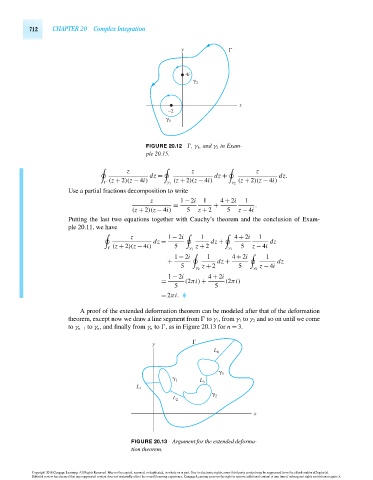Page 732 - Advanced_Engineering_Mathematics o'neil
P. 732
712 CHAPTER 20 Complex Integration
y
4i
2
x
–2
1
FIGURE 20.12 , γ 1 , and γ 2 in Exam-
ple 20.15.
z z z
dz = dz + dz.
(z + 2)(z − 4i) γ 1 (z + 2)(z − 4i) γ 2 (z + 2)(z − 4i)
Use a partial fractions decomposition to write
z 1 − 2i 1 4 + 2i 1
= + .
(z + 2)(z − 4i) 5 z + 2 5 z − 4i
Putting the last two equations together with Cauchy’s theorem and the conclusion of Exam-
ple 20.11, we have
z 1 − 2i 1 4 + 2i 1
dz = dz + dz
(z + 2)(z − 4i) 5 γ 1 z + 2 γ 1 5 z − 4i
1 − 2i 1 4 + 2i 1
+ dz + dz
5 z + 2 5 z − 4i
γ 2 γ 2
1 − 2i 4 + 2i
= (2πi) + (2πi)
5 5
=2πi.
A proof of the extended deformation theorem can be modeled after that of the deformation
theorem, except now we draw a line segment from to γ 1 , from γ 1 to γ 2 and so on until we come
to γ n−1 to γ n , and finally from γ n to , as in Figure 20.13 for n = 3.
y
L 4
3
1 L 3
L 1
L 2 2
x
FIGURE 20.13 Argument for the extended deforma-
tion theorem.
Copyright 2010 Cengage Learning. All Rights Reserved. May not be copied, scanned, or duplicated, in whole or in part. Due to electronic rights, some third party content may be suppressed from the eBook and/or eChapter(s).
Editorial review has deemed that any suppressed content does not materially affect the overall learning experience. Cengage Learning reserves the right to remove additional content at any time if subsequent rights restrictions require it.
October 14, 2010 15:32 THM/NEIL Page-712 27410_20_ch20_p695-714

